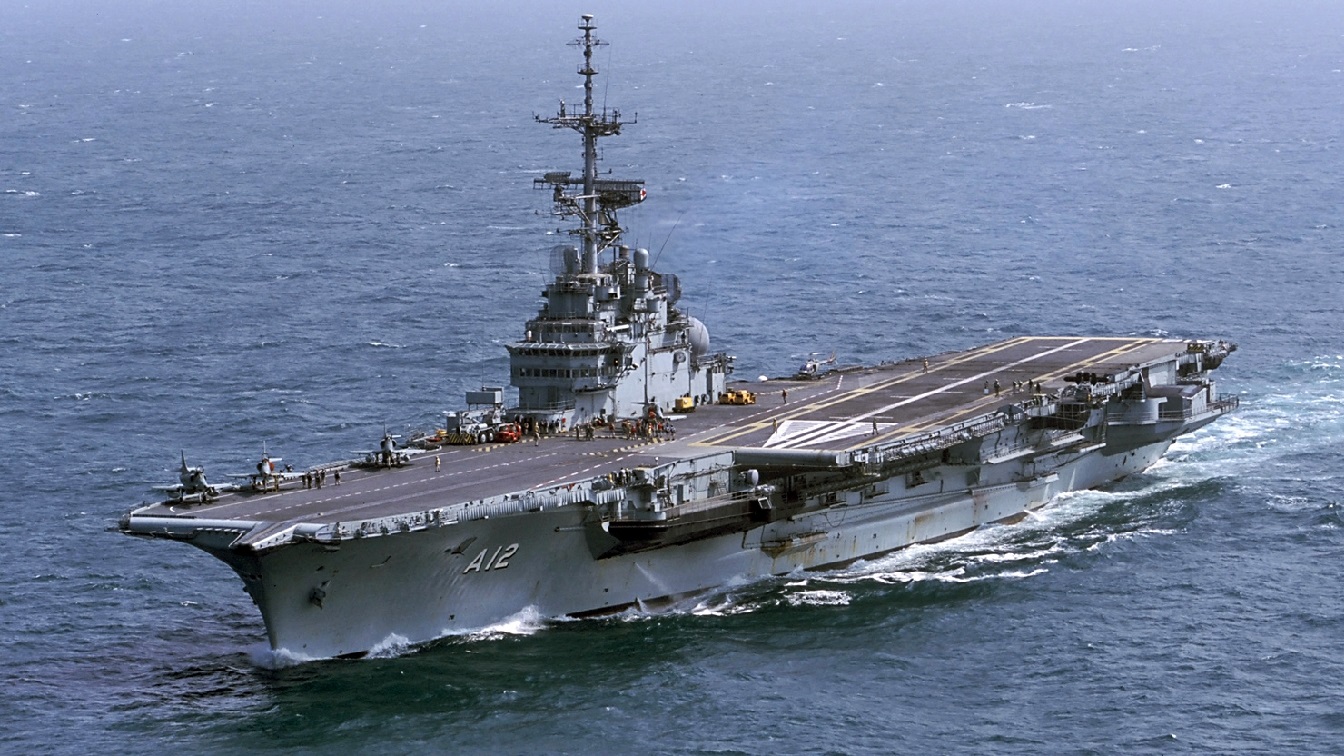Despite a protest from Brazil’s Environmental Ministry, the Brazilian Navy has announced plans to scuttle and sink its decommissioned aircraft carrier in the Atlantic Ocean. The 32,000-tonne NAe São Paulo has been floating off the Brazilian coast for three months after Turkey refused its entry to be scrapped.
Efforts had previously seen the 1960s-era French-built Clemenceau-class aircraft carrier, commissioned originally as the Foch for the French Marine Nationale, towed by tug to Europe last summer. However, the warship wasn’t allowed through the Gibraltar Straits and returned back across the Atlantic after Ankara deemed it to be an environmental hazard.
The ship is heavily laden with asbestos and other toxic materials. Brazilian officials have contended those are problems for the scrapper, but the Turkish recycling firm Sok Denizcilik Tic Sti refused to accept the hulk, claiming that the amount of hazardous materials is far greater than estimated. Some sources claim the ship may carry 9.6 tons of the cancer-causing material, while others say it could be closer to around 600 tons.
Past evidence certainly suggests the amount of asbestos on board could skew closer to the higher estimates, especially as the carrier’s sister ship – the French Navy carrier Clemenceau – contained more than 700 tons of asbestos when she was sent for scrapping in India nearly two decades ago.
No One Wants the Carrier
In August, Turkey’s Environmental Ministry revoked the import license for the vessel, while the Brazilian Environmental Agency (IBAMA) ordered the ship towed back to Brazil – where domestic ports also blocked its entry. The Brazilian courts sided with the ports, and the ship has since remained at sea.
The fight between the Turkish scrapper and the Brazilian Navy has continued. But time is running out, and a decision was made to sink the ship. Last month, Environment Minister Marina Silva formally requested that the vessel not be sunk, but Brazil was left with few other options.
The carrier is now taking on water, and the Brazilian Navy warned that there is a likelihood the vessel would sink. As a result, a decision was made to scuttle the ship in water about 5,000 meters (2,700 fathoms) deep and about 350 kilometers (218 miles) off-shore still within Brazil’s exclusive economic zone. The site is reported to be far from environmental protection areas while it is also free of undersea communication cables.
“Given its deteriorating floating condition and the inevitability of uncontrolled sinking, there is no other option but to jettison the hull and sink it in a planned way,” the Brazilian Navy said in a statement.
Lesson Learned: Don’t Buy a Used Aircraft Carrier
This could be an expensive lesson for Brazil, which acquired the former French aircraft carrier in 2000. Refitted and recommissioned as São Paulo, she replaced the former British-made Colossus-class flattop operated by Brazil as the Minas Gerais.
Though São Paulo was meant to greatly increase the capability of the Brazilian Navy, she had a remarkably bad service record. During 16 years in service, the carrier never managed more than three months of operations between maintenance periods. In addition, Brazil struggled to deploy the ship due to funding problems, and the carrier was mainly used for pilot training in port.
The ship further suffered two fires, which required significant repairs. There were some calls to modernize the vessel, which could have allowed it to serve until the late 2030s. But in 2017, the Brazilian Navy decided against further investment, which was found to be uneconomical. Instead, the carrier was formally decommissioned in 2018.
There had been discussions to preserve the carrier as a museum, while another plan was to transfer the vessel for use as a training carrier by the Turkish Navy. However, the latter plan was scuttled because the bilateral agreement between Paris and Brasília stipulated that Brazil would be the ship’s “final user.”
Now instead, it is the carrier that will be scuttled, perhaps the best outcome for the Brazilian Navy.
MORE: Ukraine Needs M1 Abrams Tanks Now (But Will Have to Wait)
MORE: Joe Biden Won’t Send F-16 Fighters to Ukraine
MORE: Why Putin Should Fear the F-16 Fighter
MORE: Why Donald Trump Can’t Win in 2024
Author Experience and Expertise: A Senior Editor for 19FortyFive, Peter Suciu is a Michigan-based writer. He has contributed to more than four dozen magazines, newspapers, and websites with over 3,200 published pieces over a twenty-year career in journalism. He regularly writes about military hardware, firearms history, cybersecurity, politics, and international affairs. Peter is also a Contributing Writer for Forbes and Clearance Jobs. You can follow him on Twitter: @PeterSuciu.

